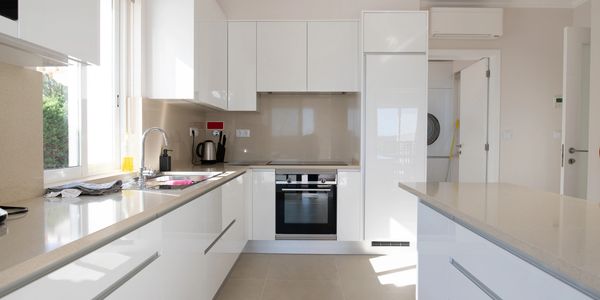Modular Kitchen

What is a Modular Kitchen?
A Modular Kitchen is a pre-designed kitchen layout made of individual cabinet modules that are factory-built and assembled on-site.
Definition Points:
- Tailor-made for optimized use of available space.
- Comprises base units, wall units, tall storage, and accessories.
- Offers sleek finishes and modern designs.
- Easily repairable and upgradable without dismantling the entire setup.

What kitchen layouts are available?
We design all popular modular kitchen layouts based on your space and utility:
- L-Shaped Kitchen – Best for corner spaces.
- U-Shaped Kitchen – Great for large kitchens with 3-side access.
- Parallel Kitchen – Efficient for small kitchens and apartments.
- Island Kitchen – Ideal for open layouts.
- Straight Line Kitchen – Perfect for compact areas.out how we can help bring your project to life.

Why choose a Modular Kitchen over a Traditional Kitchen?
Traditional Kitchen
- Built on-site
- Messy & time-consuming
- Low flexibility
- Difficult to repair
Modular Kitchen
- Pre-fabricated and factory-made
- Clean, quick installation
- Highly customizable
- Easy maintenance & replacement

What materials do you use for modular kitchen cabinets?
Cabinet Material #1: Wood
Wooden kitchens are pricey, but they last a long time.
Although it is more costly, real wood may be utilized to construct a modular kitchen. However, defects such as knots and splinters might have an impact on the overall appearance. Termites may also represent a severe hazard to the timber. However, if you have genuine wood, you may take these precautions to protect yourself against termites. There have been numerous instances when measures against termites and dampness are ineffective after a few years.
Pros: Knicks and scratches are easily repairable, Wood cabinets can be painted or re-stained to recreate a new look.
Cons: Termites, Moisture absorption, High price, Less durable, Not easy to clean, Can’t sustain exposure to humidity and steam which is always present in any kitchen.
Expert Advice: If you have a decent budget, and the cons don’t bother you, you may go with wood as your kitchen cabinet material.
Cabinet Material #2: Plywood
Plywood is selected because of its strength.
This is engineered wood, which is created from veneer sheets that have been pressed with resins. Despite being slightly more expensive, this is the most popular material in the kitchen due to its robustness. Because of its water-resistance offers variations such as Boiling Water Resistant Ply and Moisture Resistant (MR) Ply, which perform well in kitchens.
Pros: Water resistance, Does not shrink, stronger than other engineered woods.
Cons: Not a good choice for elaborate designs, Pests, Bugs, Plywood is pricey, It is less durable, Not easy to clean, Can’t sustain exposure to steam.
Expert Advice: Because kitchens are exposed to steam and water, you may go for Boiling Water-Resistant (BWR) ply over commercial ply. Because of their water resilience, they function well in kitchens. However there are may instances where it bends or sags over time and is a very common issue faced by many indian homes. When exposed to water over an extended period of time, the layers of plywood might separate.
Cabinet Material #3: MDF
If you are on a concise budget you may go for an MDF.
Medium-Density Fibreboard is comprised of tiny hardwood fibres that have been resin-glued together and hot-pressed. This is a low-cost alternative that can have any finish applied to it. Because it is engineered wood, it is more resistant to termites and has a smooth surface.
Pros: MDF is denser, Cheap, Does not crack with temperature change
Cons: MDF is relatively difficult to work with in customized designs, Soaks water and swells, MDF does not hold nails and screws well, Termites, Moisture absorption, Less durable, Not easy to clean, Can’t sustain much exposure to steam
Expert Advice: If you want an MDF kitchen, you may always use BWR ply for the cabinets behind the sink.MDF is denser, Cheap, Does not crack with temperature change
Cons: MDF is relatively difficult to work with in customized designs, Soaks water and swells, MDF does not hold nails and screws well, Termites, Moisture absorption, Less durable, Not easy to clean, Can’t sustain much exposure to steam
Expert Advice: If you want an MDF kitchen, you may always use BWR ply for the cabinets behind the sink.
Cabinet Material #4: Particle Board
When there is little labour to be done in the kitchen, particleboard is excellent.
Particleboard, the cheapest material on the market, is manufactured from sawdust and scrap wood, which is one of the reasons why its quality is questioned. Because this material is heavy, it cannot support more weight. It is appropriate for kitchens that are only used for light cooking.
Pros: Low cost, Smooth surfaces, Light weight,
Cons: Very low durability, Toxic in nature, it expands, warps and discolours easily. Termites, Moisture absorption, Doesn’t hold screws and nails tightly, not water resistant.
Expert Advice: In addition to being cost-effective, particleboard is also environmentally beneficial since it is created from waste wood from manufacturing other engineered woods, reducing landfill waste.However, particle board is better suited for light weight, ready-made furniture rather than kitchen areas, which are often used.
Cabinet Material #5: PVC
PVC kitchens are unsuitable for long-term use.
PVC is one of the most cost-effective kitchen cabinet materials since it is simple to clean and maintain. PVC boards for kitchens are currently available in two varieties: hollow boards and foam. While the former is heavier and more durable, the latter is lighter and more cost-effective. The primary benefits of PVC kitchens are that they are simple to install and come in a variety of colours.
Pros: Customized design as per requirement
Cons: Termites, Moisture absorption, High price, Less durable, Not easy to clean, Can’t sustain much exposure to steam
Expert Advice: Choose foam board over hollow PVC boards since it is stronger and can hold greater weight. However, PVC is not as durable as other materials and should only be used as a temporary remedy.
Cabinet Material #6: Stainless Steel
Stainless steel is anti-fungal and anti-microbial.
Stainless steel is the newest material for kitchen cabinets in the post-pandemic era, and it is steadily infiltrating the Indian market. It is due to its antifungal and antimicrobial characteristics. They are more robust, weather and corrosion-resistant, and simple to clean.
Pros: Highly durable, Sleek, Classy and elegant look, Anti microbial, Resistance to moisture, steam, Stain free, Non Absorbent, Very easy to clean and maintain hygiene, Corrosion Reistant, Termite & Pests free, Can sustain high temperatures, Stainless steel modular kitchens are fire-proof, eco-friendly & sustainable choice.
Cons: Slight pricey almost as the high quality wood, needs to be precisely manufacturedand installed by specialized team with expertise in Stainless Steel.
Expert Advice: If you want your modular kitchen to be easy in maintenance and have a sleek appearance, a stainless steel kitchen is an ideal option for you. Let us now have a look at the comparison chart for all the materials discussed above.Popular Options:
BWP/BWR Plywood – Boiling Water Resistant and termite-proof.
HDHMR Boards – High Density High Moisture Resistance.
MDF/Particle Boards – Budget-friendly alternatives for low-moisture zones.
What finishes can I choose for kitchen shutters and cabinets?
We offer a wide variety of finishes depending on your budget and design preference:
- Laminate (Matte/Glossy) – Durable and easy to clean.
- Acrylic – Premium high-gloss finish with a modern look.
- PU (Polyurethane) Paint – Luxurious, high-end finish.
- Veneer/Wood – Natural warmth and texture.
- Glass Shutters – For a sleek and airy design.
Which are the best kitchen hardware & accessory brands you use?
We use top Indian and international brands for durability and smooth functionality:
- Hettich (Germany)
- Blum (Austria)
- Häfele
- Godrej Interio
- Ebco
- Ozone
These brands offer soft-close hinges, tandem drawers, tall units, corner carousels, bottle pull-outs, and cutlery organizers that make your kitchen ultra-functional.
Can you integrate kitchen appliances like hob, chimney, microwave, etc.?
Yes. We offer full built-in appliance integration for:
- Hob & Chimney
- Microwave Oven
- Dishwasher
- Refrigerator
- Water Purifier
We work with prestigious brands like Faber, Elica, Bosch, Kaff, and Hindware for seamless integration.
What is the typical timeline for completion of a modular kitchen?
✅ UrbanRoots USP: We follow a 100% deadline-driven approach — delivering as per Indian service industry standards.
- Basic Modular Kitchen: 10–15 working days
- Premium/Custom Design: 20–30 working days
- Includes 3D rendering, material procurement, civil prep, and final assembly.
.
Do you also manage civil and electrical work for the kitchen?
Yes. Unlike other designers, UrbanRoots Developer has an in-house civil and electrical team.
We handle:
- Plumbing line setups for sinks and dishwashers.
- Electrical layout planning for appliances and lighting.
- Civil work for countertops, tiling, false ceiling, and wall treatment.
What makes UrbanRoots Developer stand out in the market?
🟢 Our Unique Selling Points:
- Integrated Services: From interior designing to civil construction and exterior elevation.
- Deadline-Driven Delivery: Projects completed on time, as per industry best practices in India.
- Custom 3D Design Visuals: View your kitchen before it's built.
- Use of Premium Brands: No compromise on quality.
- Affordable Pricing: Tailored solutions for every budget.
- Post-Installation Support: Warranty and maintenance options included.
Do you provide service outside of Varanasi?
Yes. Though we are based in Varanasi, we serve all of Uttar Pradesh and take on selected projects pan India based on project scope and timelines.
What is the cost of a modular kitchen?
The price depends on layout, size, materials, and accessories.
Average Costing (Indicative):
- Basic Model: ₹1.5 – ₹2.5 Lakhs
- Mid-Range: ₹2.5 – ₹4 Lakhs
- Premium: ₹4 Lakhs and above

Do you offer EMI or payment flexibility?
Yes. We offer:
- Milestone-based payments tied to progress stages.
- Assistance with EMI options through partner finance companies (if required).

Is the modular kitchen covered under warranty?
Yes, we offer:
- 5–10 years warranty on hardware (brand dependent).
- 1–3 years warranty on installation and workmanship.

What post-installation support do you provide?
- Free servicing during the warranty period.
- Paid maintenance packages for extended support.
- On-call assistance and technician visits.

Let’s Build Your Dream Kitchen
If you’re searching for the:
- Best & Economical Interior Designer in Varanasi
- Top Modular Kitchen Expert in Uttar Pradesh
- Reliable & Deadline-Focused Team in India
UrbanRoots Developer is your one-stop solution.
📞 Call Us 9999388366 Today for a Free Site Visit & Estimate
🌐 Visit: www.urbanrootsdeveloper.com
]
📍 Locations: Varanasi | Lucknow | Prayagraj | Gorakhpur | Pan India
UrbanRoots Developer
RZ - 99 /70, Janakpuri, Uttam Nagar, New Delhi - 1100059

Announcement
Welcome! Schedule your appointment today and enjoy an exclusive 5% discount on your total project cost. Don't miss this limited-time reward—let’s bring your dream space to life!
